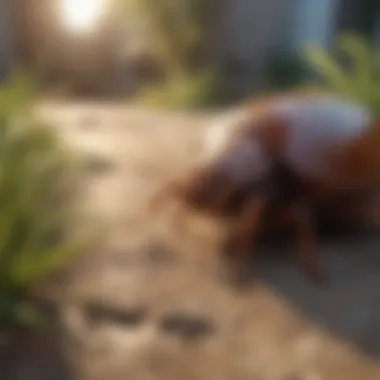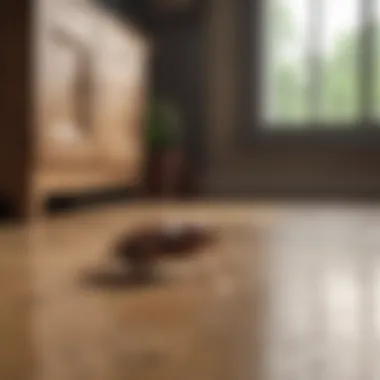Safe Cockroach Control Strategies for Pet Owners


Intro
Cockroaches can turn any peaceful home into a battleground. Imagine walking into your kitchen only to be greeted by these unwelcome guests scuttling across your countertop. With so many conventional pest control methods available, it’s natural to think that getting rid of cockroaches should be a piece of cake. However, the challenge arises when you have pets at home. Many traditional pest-control solutions can harm your four-legged friends or even result in life-threatening situations.
Thus, the quest for effective yet pet-safe strategies to eliminate these pests is essential for pet owners. This article not only delves into practical methods to eradicate cockroaches but also prioritizes the safety and well-being of household pets. In doing so, it provides comprehensive insights that strike a balance between pest elimination and pet safety, thus maintaining a harmonious living environment.
Throughout the following sections, we will explore various eco-friendly solutions, preventative measures, and natural deterrents. Whether you are a busy parent juggling responsibilities or a professional seeking efficient methods, this guide has you covered. Let’s dive into effective strategies that keep both your home pest-free and your pets unharmed.
Understanding the Cockroach Problem
Understanding the cockroach problem is crucial for anyone who values a clean and healthy home, especially those with pets. These creatures are not just unsightly; they can pose serious health risks and contribute to a discomforting household environment. Gaining insight into the biology and habits of cockroaches helps in developing effective methods for their eradication without jeopardizing the safety of your furry companions.
Biology and Habits of Cockroaches
Cockroaches are cunning little critters. They usually come alive at night, thrive in warm temperatures, and are more than capable of fitting into tight spaces. A few characteristics make them experts at survival:
- Reproduction: A single female can produce hundreds of offspring in her lifetime, necessitating swift action once they invade.
- Diet: They are omnivorous, munching on leftovers, crumbs, or even non-food items such as glue, soap, and paper. This adaptability makes them hard to detect until the infestation is significant.
- Hiding Places: These pests often lurk behind appliances, under sinks, and in dark corners, making them an unwelcome surprise in the home.
Understanding these habits equips homeowners to tackle an infestation decisively.
Why Cockroaches Intrude Homes
So, why exactly do cockroaches invade our living spaces? The answer lies in their pursuit of shelter, sustenance, and warmth.
- Food Sources: Kitchens are often their favorite haunt, where crumbs and spills become a feast. If food isn't stored properly, your home becomes a smorgasbord.
- Shelter: Particularly in urban settings, they find haven inside walls and areas that are often neglected, like basements or attics.
- Warmth and Moisture: Cockroaches are attracted to warmth—yes, they can tell when your heat's cranked up a notch! They also crave moisture, thus bathrooms and kitchens are prime targets.
Understanding these triggers can help devise an effective plan to deter them. Keeping a clean home, sealing entry points, and managing moisture can significantly reduce the chances of an infestation.
Risks Associated with Chemical Extermination
When addressing the issue of cockroaches in our homes, many people often default to chemical extermination as the first line of defense. However, this choice comes with its own set of challenges and considerations, especially when pets are part of the household. Understanding the risks associated with chemical extermination is crucial for maintaining a safe environment for all living beings in the home.
Toxicity to Pets
Many popular pest control ingredients are notorious for their toxicity. Products containing pyrethroids, for instance, can be particularly harmful to cats and dogs. While these chemicals effectively eliminate pests, they can cause serious health concerns for pets if ingested or inhaled. Symptoms of exposure may include drooling, vomiting, or more severe reactions like seizures.
- What to keep in mind:
- Ingredients: Always read the labels and understand what chemicals are present. Some may list "pet-safe" but can still pose risks.
- Usage Directions: Following the instructions is not just a suggestion; it’s essential to avoid overapplication or misuse.
- Anticipate Contact: Young or playful pets can easily come into contact with treated areas, so timing is critical.
"The implications of using chemical pesticides extend beyond mere pest eradication; pet safety should always be the primary concern."
Environmental Impact
Using chemical extermination methods not only affects household pets but also has broader environmental ramifications. Chemicals can seep into water systems, affect garden soil, and even harm local wildlife. When these pesticides are washed away during rain, they can create runoff that contaminates nearby water sources. This presents a challenge not only to wildlife but also to humans who depend on those resources.
- Consider the following effects:
- Biodiversity Loss: Intense chemical use can decimate beneficial insect populations, further upsetting the ecological balance.
- Chemical Residue: Pesticide residues can linger in the home, posing a continuous risk long after application.
- Health Concerns: There’s a rising concern about the correlation between pesticide exposure and health issues in humans, including respiratory problems and even cancer.
In light of these factors, it becomes evident that opting for chemical extermination isn’t as straightforward as it might seem. While the allure of immediate elimination of cockroaches can be tempting, the risks associated with such methods underscore the importance of seeking safer, more natural alternatives.


Natural Methods for Cockroach Control
Effective strategies for eliminating cockroaches often steer toward natural methods, particularly when the health of pets is a priority. Chemical pesticides, while they may promise rapid results, can pose significant risks not only to furry companions but also to the broader environment. Natural methods are typically safer, easier to access, and can often be just as effective in keeping your home free from unwanted cockroach guests. Furthermore, by utilizing these approaches, one can foster a home environment that's safe and conducive for all its inhabitants. Bypassing harsh chemicals opens the door to healthier living conditions.
Diatomaceous Earth as a Deterrent
Diatomaceous earth (DE) is a remarkable substance when it comes to pest control. It's a fine powder made from the fossilized remains of tiny aquatic organisms called diatoms. This white, chalky substance works wonders against cockroaches by dehydrating them. When these pests come into contact with it, the sharp edges of the particles scratch their exoskeletons, leading to immediate fluid loss and eventual death.
To use diatomaceous earth, simply sprinkle a thin layer in areas cockroaches frequent, like behind appliances or in dark corners of the kitchen. It’s crucial, though, to choose food-grade DE to ensure it's safe for pets. This method offers a dual benefit: not only does it trap and kill cockroaches, but it can also repel them from returning, effectively creating an inhospitable environment.
"Ensure the DE is kept dry; moisture nullifies its effectiveness."
It's important to note that while DE is a natural and effective solution, it should be reapplied occasionally, particularly after cleaning or if it gets wet. Regular treatment keeps the barriers up, ensuring your home remains a cockroach-free haven without endangering your pets.
Boric Acid: Safe Usage Around Pets
Boric acid has long been heralded as a potent solution for insect infestations, particularly cockroaches. When it comes to usage, safety is paramount, especially for households with pets roaming about. However, the good news is that with careful application, boric acid can effectively target cockroaches without endangering your loyal furry friends.
The key here is to apply boric acid in carefully monitored areas. Mix a small amount with sugar to create an attractant, then place it in bait stations that your pets can't easily access. Cockroaches, lured by the sugar, will ingest the boric acid, effectively curbing the population. This method not only controls cockroach numbers but does so in a way that is measured and controlled.
It’s worth remembering that while boric acid is generally considered safe, ingestion in significant amounts can lead to health issues in pets. Hence, keep it well out of reach, and ensure you monitor any bait stations regularly. This way, you can still maintain a pest-free home without compromising the safety and health of your furry companions.
Essential Oils as Repellents
Essential oils, often overlooked in pest control conversations, can serve as a delightful and aromatic weapon against cockroaches. Oils such as peppermint, lavender, and tea tree can deter these pests due to their potent scents. The great thing about using essential oils is that they offer a natural and non-toxic method to keep cockroaches at bay while also being safe for pets.
To harness the power of essential oils, you can create a homemade spray. Dilute about 10-15 drops of essential oil in water, and pair it with a splash of dish soap for increased adherence. Apply this mixture in areas where you've spotted roaches or suspect they might enter your home.
Regular application can build up a protective barrier that cockroaches are less inclined to cross. While the effectiveness might vary, many homeowners have found success by incorporating essential oils into their pest control routine.
Homemade Traps and Baits
Creating your own traps and baits serves as an effective and pet-safe strategy to keep those pesky cockroaches at bay. Unlike commercial pesticides, these homemade solutions are generally free from harmful chemicals that can pose risks to pets and children. The cost-effectiveness of using household items is an added bonus, making it accessible for anyone looking to tackle a cockroach problem without breaking the bank.
Sugar and Baking Soda Mixture
One of the simplest and most effective homemade traps involves a mixture of sugar and baking soda. This combination works wonders because cockroaches are drawn to sugar, while baking soda can be lethal to them once ingested. The beauty of this method lies in its dual action:
- Attraction: Sugar lures the cockroaches into your trap.
- Elimination: When they consume the baking soda, it reacts with the acid in their digestive system, ultimately leading to their demise.
To create this trap, you do the following:
- Combine equal parts of baking soda and sugar in a small bowl or plate.
- Place the mixture in areas where cockroaches are commonly seen, such as under sinks or behind appliances.
- Ensure that your pets cannot access these traps by placing them in spots that are out of reach.
Soap and Water Solution
Another home remedy to consider is a straightforward soap and water mixture. This method utilizes basic dish soap to suffocate cockroaches. The soap reduces the surface tension of the water, causing the roaches to sink rather than float on the surface.
- How It Works: When cockroaches come into contact with this solution, it effectively blocks their breathing pores, leading to a quick end.
To make the soap and water trap:


- Fill a spray bottle with water and add a few tablespoons of liquid dish soap. Mix it well until you see bubbles.
- Spray the solution directly on any cockroaches you spot—this instant treatment works fast.
- For a more permanent solution, consider leaving a bowl of the solution in areas frequented by the critters, ensuring it's again out of your pets’ reach.
These homemade traps and baits not only provide a practical solution to a infestations but also foster a sense of security among pet owners, knowing that they can combat cockroaches without putting their furry friends at risk. Think of these methods as part of a broader strategy of hygiene and prevention to keep your living space enjoyable and pest-free.
Preventative Measures for Cockroach Infestations
Preventing cockroach infestations should be at the forefront of any pest management strategy, especially for those with pets. Cockroaches are known for their rapid reproductive capabilities and can quickly turn a minor issue into a major problem. By implementing effective preventative measures, homeowners can ward off these unwanted intruders, thus ensuring a safe and clean environment for both their families and furry companions.
First and foremost, understanding that prevention is often more effective—and indeed, easier—than dealing with an infestation is crucial. Investing time and effort into preventative strategies can save you a ton of trouble down the line. A wise adage comes to mind: "An ounce of prevention is worth a pound of cure." This holds especially true when it comes to managing pests like cockroaches.
Sealing Entry Points
One key aspect of preventing cockroaches from entering your home is the sealing of any potential entry points. These tenacious bugs can squeeze through surprisingly small gaps—think the size of a dime.
- Inspect Your Home: Start by conducting a thorough inspection of your home, particularly around doors, windows, and foundations. Look for cracks or crevices where cockroaches might sneak in.
- Use Caulk or Sealant: Use caulk or a high-quality sealant to close these gaps. Pay special attention to areas around plumbing pipes and ventilation ducts, where gaps may form over time.
- Weather Stripping: Install weather stripping around doors and windows for an added buffer against entry. Not only will this help keep pests at bay, but it will also improve your home’s energy efficiency.
By sealing off these entry points, you create a physical barrier that makes it harder for cockroaches to invade your living space.
Proper Food Storage Techniques
Food is one of the primary attractants for cockroaches, making effective food storage techniques critical in pest prevention. If roaches find a buffet in your kitchen, they will establish themselves faster than you can say "roach spray."
- Use Airtight Containers: Store all food items in airtight, heavy containers to prevent access. This includes pet food, as it can also attract these pests.
- Clean Up Spills Promptly: Don’t wait until later; clean up any spills or crumbs from cooking and eating right away.
- Regular Trash Disposal: Empty your trash bins regularly and secure the bags tightly. Consider using bins with tight-fitting lids.
When food is stored properly, it removes that enticing invitation that cockroaches cannot resist, significantly reducing the chance they’ll set up camp in your home.
Cleaning Habits to Deter Cockroaches
Maintaining cleanliness is perhaps the simplest yet most effective way to deter cockroaches. A clean environment is less appealing to these pests.
- Daily Routines: Make it a habit to wipe down surfaces daily. Clutter is also a no-go; try to keep areas tidy, reducing the hiding spots for cockroaches.
- Focus on Dark Spaces: Make sure to regularly clean areas that might be out of sight, like beneath the stove or behind appliances. These dark and dank spots are often where cockroaches thrive.
- Wash Dishes Promptly: Don’t leave dirty dishes overnight. The leftover food can serve as an open invitation for unwanted guests.
The key to keeping cockroaches at bay is to be proactive with cleanliness and organization throughout your home. Regularly employing these cleaning habits can turn your living space into an unwelcoming environment for cockroaches.
By incorporating these preventative measures in your routine, you not only protect your home from cockroach infestations but also create a more pleasant space for your family and pets.
Using Professional Pest Control Services
When faced with a cockroach infestation, homeowners might find themselves at a crossroads: tackle the problem using DIY methods or bring in the professionals. Hiring an expert pest control service can be essential, especially if you have pets in your home. The benefits these professionals offer extend far beyond mere elimination of pests; they focus on safe practices that prioritize the well-being of your furry companions. Using professional help often means leveraging the knowledge and experience that comes from years in the field, which can save you time, money, and stress in the long run.
Choosing Pet-Friendly Extermination
The first step in employing a pest control service is to ask the right questions about their practices. It's not enough just to know they handle cockroaches; it’s crucial to find out if the extermination methods employed are safe for your pets. Reputable pest control companies will often have a range of pet-friendly options that effectively address infestations without compromising the safety of your four-legged friends.
- Inquiries to consider:
- Are the products used non-toxic or labeled as pet-friendly?
- What steps can the service take to ensure my pets’ safety during and after treatment?
Many pest control experts opt for methods like gel baits or heat treatments that have proven effective against cockroaches while reducing the risks associated with chemical exposure for pets. Asking about the training and protocols that technicians use to ensure safety can give you peace of mind.
Inquiring About Methods and Products Used


An essential part of the decision-making process involves understanding the specific methods and products a pest control service intends to use. This requires not just a quick chat over the phone but a genuine dialogue about the pest management strategy. Make sure to ask:
- What products will be applied?
- How do these products work?
- What is the timeline – both for the extermination and for when it is safe for pets to return to treated areas?
Pest control services may utilize an integrated pest management approach, which includes monitoring the infestation level and combining various treatments to minimize chemical usage. Policies against certain pesticides or materials harmful to pets should be clear from the outset.
Consider also looking into customer reviews or asking for testimonials regarding their success with pet-safe techniques. It can guide your choice of provider. If you go into this process informed, you can select a service that aligns with your values and needs while maintaining a safe environment for your pets.
Remember: Effective pest control coupled with pet safety can lead to a happier and healthier home environment.
Monitoring and Maintenance
Monitoring and maintenance are the two pillars that can help ward off the persistent issue of cockroach infestations. Without them, even the most effective strategies can fall flat over time. Regular monitoring allows you to detect early signs of cockroaches and address problems before they spiral out of control. This proactive approach fosters a sense of dependent vigilance that keeps your home safe for both pets and humans.
Given the crafty nature of cockroaches, it’s essential to incorporate an organized monitoring strategy into your pest control regimen. You may find that by creating checkpoints—like habits akin to checking your mailbox for important mail—you’ll have a better grip on potential invaders. This habit not only saves you from future headaches but also helps you take stock of your home's cleanliness and overall safety.
Regular Inspection Techniques
Conducting thorough inspections of your home is like doing a regular health check-up but for your living space. Here are some techniques that can be used:
- Check Cracks and Crevices: Cockroaches love tight, dark places. Inspect areas under sinks, behind appliances, and near plumbing fixtures.
- Inspect Food Storage Areas: Look at pantry shelves and other food storage spaces for signs of nibbling or droppings. Decoying them with scent may lead you to hidden nests.
- Monitor Pet Areas: It’s essential to keep a watchful eye on where your pets eat, play, and sleep. Daily clean-up of food debris can deter cockroaches while ensuring your critters are protected.
- Look for Droppings: Their droppings often resemble black pepper. Finding them can indicate a cockroach presence that needs immediate attention.
- Use Traps: Bug traps can be placed strategically around common spaces. These not only catch invaders but also reveal hotspots of activity.
"An ounce of prevention is worth a pound of cure."
Recognizing these signs early can make the difference between a minor nuisance and a full-blown infestation.
Creating a Long-Term Maintenance Plan
Creating a long-term maintenance plan is much like building a strong foundation for a house; it requires thought, effort, and commitment. Here are a few elements to include in your strategy:
- Establish a Cleaning Schedule: Develop regular cleaning routines that include thorough vacuuming and wiping surfaces to eliminate crumbs and residues.
- Educate Household Members: Make sure all family members understand the importance of cleanliness and report any sightings or signs promptly. This may feel like herding cats, but clear communication is key.
- Regularly Inspect and Replace Traps: Change out traps frequently and keep track of what works best. This ongoing observation is crucial in adapting your strategy to evolving pest behavior.
- Expand Your Prevention Tactics: As new methods become available or others fall out of favor, integrating these into your plan can yield better results. Stay informed about natural repellents and products that have minimal impact on pets.
- Consult Professionals as Needed: Engaging a pest control professional once or twice a year can help reassess your home environment, ensuring nothing slips between the cracks.
By anchoring these practices into your daily lifestyle, you establish a long-term barrier against future cockroach inquiries into your living space. The peace of mind that comes from knowing your home is well-maintained goes a long way in fostering a cozy environment for both your family and pets.
End
Navigating the challenge of cockroach eradication while ensuring the well-being of pets is no small feat. The ramifications of a cockroach infestation stretch beyond mere inconvenience; they pose potential health hazards, property damage, and the stress of having to manage unwanted guests. Thus, employing effective and pet-safe methods to tackle these pests becomes vitally important.
Understanding the significance of this conclusion rests on several key elements:
- Balancing Act: The crux of effective pest management lies in striking a balance between effective solutions and pet safety. Utilizing chemical-free alternatives preserves the health of both humans and pets.
- Quality of Life: Maintaining a pest-free home enhances overall living conditions, reducing stress and anxiety associated with an infestation, particularly for those who have furry friends roaming around.
- Long-Term Strategies: The focus on natural methods not only addresses current infestations but can also help prevent future ones. Readers are encouraged to embed these practices into their daily routines, creating a harmonious environment that discourages cockroaches from encroaching on their space.
- Community Awareness: The discussion of pest control extends beyond individual homes. By promoting pet-friendly extermination methods, we contribute to a broader movement that values both animal welfare and environmental sustainability.
Summarizing Key Takeaways
To distill the essence of our discussion, here are the primary takeaways regarding effective cockroach control while safeguarding pets:
- Identify and Understand: Recognizing the biology and habits of cockroaches aids in developing targeted strategies.
- Emphasize Natural Solutions: Utilizing substances like diatomaceous earth, boric acid, or essential oils provides effective control while keeping pets safe.
- Invest in Prevention: Regular cleaning, proper food storage, and sealing of entry points significantly reduce the likelihood of infestations.
- Professional Help when Needed: Choosing certified pest control services that prioritize eco-friendly practices ensures that households remain pet-friendly.
Encouragement for a Balanced Approach
As we wrap up, it’s worth reflecting on the philosophy of adopting a balanced approach when dealing with cockroaches. The methods discussed throughout this article are not merely means to an end but part of a comprehensive lifestyle change.
Encouragement comes from the understanding that every small step counts. Start with integrating one or two natural methods into your cleaning routine. Notice how these actions not only improve your pest situation but also create a more positive atmosphere at home.
Furthermore, staying informed about the products used in professional pest services is crucial. Don’t hesitate to ask questions and ensure any treatments align with your household’s values of safety and well-being.
The journey to a pest-free space need not be fraught with concern over the safety of pets; rather, it can be a scheme that harmonizes living conditions for all occupants of the home. A little vigilance today leads to greater peace of mind tomorrow, making this balanced approach a wise choice for many.



